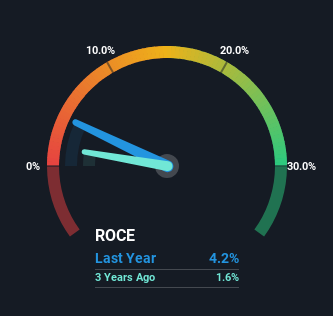- China
- /
- Electric Utilities
- /
- SHSE:600995
Investors Could Be Concerned With China Southern Power Grid Energy Storage's (SHSE:600995) Returns On Capital

If you're not sure where to start when looking for the next multi-bagger, there are a few key trends you should keep an eye out for. Firstly, we'd want to identify a growing return on capital employed (ROCE) and then alongside that, an ever-increasing base of capital employed. Ultimately, this demonstrates that it's a business that is reinvesting profits at increasing rates of return. In light of that, when we looked at China Southern Power Grid Energy Storage (SHSE:600995) and its ROCE trend, we weren't exactly thrilled.
What Is Return On Capital Employed (ROCE)?
Just to clarify if you're unsure, ROCE is a metric for evaluating how much pre-tax income (in percentage terms) a company earns on the capital invested in its business. Analysts use this formula to calculate it for China Southern Power Grid Energy Storage:
Return on Capital Employed = Earnings Before Interest and Tax (EBIT) ÷ (Total Assets - Current Liabilities)
0.042 = CN¥1.9b ÷ (CN¥47b - CN¥1.9b) (Based on the trailing twelve months to June 2024).
Therefore, China Southern Power Grid Energy Storage has an ROCE of 4.2%. On its own, that's a low figure but it's around the 4.8% average generated by the Electric Utilities industry.
Check out our latest analysis for China Southern Power Grid Energy Storage

In the above chart we have measured China Southern Power Grid Energy Storage's prior ROCE against its prior performance, but the future is arguably more important. If you'd like, you can check out the forecasts from the analysts covering China Southern Power Grid Energy Storage for free.
How Are Returns Trending?
On the surface, the trend of ROCE at China Southern Power Grid Energy Storage doesn't inspire confidence. To be more specific, ROCE has fallen from 15% over the last five years. And considering revenue has dropped while employing more capital, we'd be cautious. This could mean that the business is losing its competitive advantage or market share, because while more money is being put into ventures, it's actually producing a lower return - "less bang for their buck" per se.
On a side note, China Southern Power Grid Energy Storage has done well to pay down its current liabilities to 4.0% of total assets. So we could link some of this to the decrease in ROCE. Effectively this means their suppliers or short-term creditors are funding less of the business, which reduces some elements of risk. Since the business is basically funding more of its operations with it's own money, you could argue this has made the business less efficient at generating ROCE.
Our Take On China Southern Power Grid Energy Storage's ROCE
From the above analysis, we find it rather worrisome that returns on capital and sales for China Southern Power Grid Energy Storage have fallen, meanwhile the business is employing more capital than it was five years ago. Yet despite these concerning fundamentals, the stock has performed strongly with a 41% return over the last five years, so investors appear very optimistic. In any case, the current underlying trends don't bode well for long term performance so unless they reverse, we'd start looking elsewhere.
One final note, you should learn about the 2 warning signs we've spotted with China Southern Power Grid Energy Storage (including 1 which doesn't sit too well with us) .
If you want to search for solid companies with great earnings, check out this free list of companies with good balance sheets and impressive returns on equity.
New: AI Stock Screener & Alerts
Our new AI Stock Screener scans the market every day to uncover opportunities.
• Dividend Powerhouses (3%+ Yield)
• Undervalued Small Caps with Insider Buying
• High growth Tech and AI Companies
Or build your own from over 50 metrics.
Have feedback on this article? Concerned about the content? Get in touch with us directly. Alternatively, email editorial-team (at) simplywallst.com.
This article by Simply Wall St is general in nature. We provide commentary based on historical data and analyst forecasts only using an unbiased methodology and our articles are not intended to be financial advice. It does not constitute a recommendation to buy or sell any stock, and does not take account of your objectives, or your financial situation. We aim to bring you long-term focused analysis driven by fundamental data. Note that our analysis may not factor in the latest price-sensitive company announcements or qualitative material. Simply Wall St has no position in any stocks mentioned.
About SHSE:600995
China Southern Power Grid Energy Storage
China Southern Power Grid Energy Storage Co., Ltd.
Solid track record second-rate dividend payer.
Market Insights
Community Narratives


